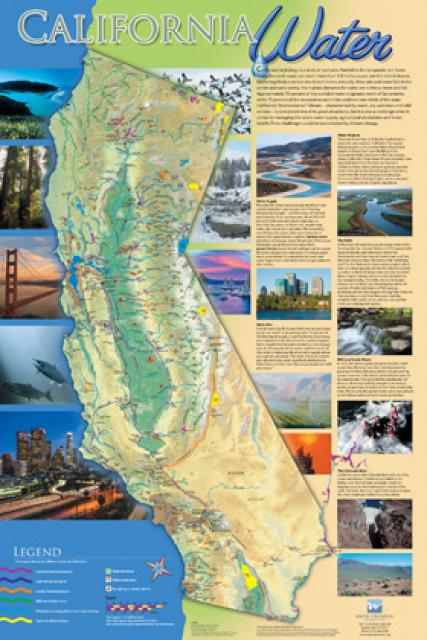California Project WET Gazette
Autumn 2025
Changes in the Waters
“Life is a series of natural and spontaneous changes. Don’t resist them; that only creates sorrow. Let reality be reality. Let things flow naturally forward in whatever way they like.”
― Lao Tzu, Chinese Philosopher
 As summer moves to fall this year, so too is the Water Education Foundation’s California Project WET program transitioning from one coordinator to the next. As your state coordinator for the program over the past 21 years, working with all the educators, partners and fellow project WET coordinators has been a pleasure. Many of you have attended multiple Project WET workshops over the years, becoming very much like family and I am going to miss being able to catch up with you when you attend your next workshop!
As summer moves to fall this year, so too is the Water Education Foundation’s California Project WET program transitioning from one coordinator to the next. As your state coordinator for the program over the past 21 years, working with all the educators, partners and fellow project WET coordinators has been a pleasure. Many of you have attended multiple Project WET workshops over the years, becoming very much like family and I am going to miss being able to catch up with you when you attend your next workshop!
However, I’m leaving the program in the very capable hands of Nic Russo – a veteran high school teacher, environmental educator and one who enjoys tinkering with how best to lead activities to help learners of any age better understand natural science topics as much as I do. You’ll be learning more about Nic as he takes the helm, and I’m sure you’ll enjoy your next workshop with Nic as the lead.
As for me, I am retiring from the Water Education Foundation on Sept. 11 and will be on the way to Missouri, where I will literally be going back to the fork in the road I was standing at after graduating from Humboldt State University with degrees in forestry and social sciences. I’ve found an abundance of adventure on the path of teaching and education and expect to find plenty more as I head down the forest management track – specifically the management of fire and fuels. And I’m happy to say I will not be alone as I travel this road with my soon-to-be-wife, who lights up my life like the fireflies in a Missouri forest!
I’ve also had fun writing this newsletter and will leave you with links to some of the favorites readers have identified over the years in the Websites of Interest section of this newsletter. You’ll also find a variety of Autumn Events and Professional Development Opportunities to enjoy this season, as well as Grants and Student Contests to consider.
Hope you have a wonderful fall!
“I just go with the flow like a twig on the shoulders of a mighty stream.”
― Del Griffith, Shower Curtain Ring Salesman
WEBSITES OF INTEREST
Water Education Foundation: Favorite Past Gazettes
At the core of the Godzilla allegory are questions of how science and technology – in fact all the STEM (science, technology, engineering & math) fields – are interpreted and applied. It is no surprise the movie has Godzilla wading ashore in California, where climate change is the Godzilla in the room and the science surrounding is at the center of a political and economic gyre of debate
I can already sense the hackles rising with the tone of disgust escaping the lips of the most hardcore science advocates among us at the mere sight of the article title. What a ridiculous concept; the idea that one can predict future weather by dragging a hibernating rodent out of its lair and observing its reaction to the current above ground conditions…
One could argue it all began with John Colter. In 1808, this former member of Lewis and Clark’s Corps of Discovery returned from a winter trek deep into the mountainous area of what is now northwestern Wyoming describing a land of boiling mud, exploding waters and a pervasive, sulfurous stench that led disbelieving listeners to deride this fanciful place as ‘Colter’s Hell.’
Twenty Thousand Leagues Under the Sea
The sea is everything. It covers seven tenths of the terrestrial globe. Its breath is pure and healthy. It is an immense desert, where man is never lonely, for he feels life stirring on all sides. The sea is only the embodiment of a supernatural and wonderful existence. It is nothing but love and emotion; it is the Living Infinite.” – Jules Verne, ‘Twenty Thousand Leagues Under the Sea’
Double, Double Toil and Trouble…
Rock snot… Quagga… Rattlebox… They sound like ingredients for a witch’s cauldron that Shakespeare missed, but they are names of actual species wreaking havoc on ecological systems and watersheds California. Most do not have names that generate a sense of foreboding or disgust as these may and quite a few can appear as cute and innocuous as the trick or treaters knocking on doors later this season.
For those unfamiliar, “The Princess Bride” was a modern, fractured fairy tale about the love of a princess and a peasant boy… However, the image that first flashes into my mind when the movie is mentioned are the ROUS – Rodents of Unusual Size – of the mythical Fire Swamp–and the same image has been popping into mind with the recent flurry of articles about the discovery of nutria in California.
Spring for many brings thoughts of blooming flowers, a re-greening of the landscape, a steady warming and ever-lengthening days in anticipation of summer. For me, those are just markers counting down to when the soil underfoot has become friable enough to gather in hand to feel the moist, flour-like crumble of a good loam, the gritty texture of sand and the slickness of clay particles.
Then there is the ring. Forged by human hands, its power binds and controls all other rings as its destructive influence grows throughout the story. It is hard for anyone who studies natural cycles to not see an allegory to the growing evidence that a climate cycle supercharged by rampant increases in atmospheric carbon dioxide is increasing extreme events in the water, weather, life, fire and flood cycles of California.
Water & Traditional Ecological Knowledge in a Changing Climate
Years ago, I had the pleasure of exploring the canyon country in the Four Corners region of the Colorado River watershed. I was especially fascinated with the ruins of past civilizations that seemed to be present under every rock overhang and hidden crevice throughout the region. Among the remnants were pictographs and petroglyphs, symbols etched or painted into rock by these past cultures that one can learn about in the Project WET activity ‘Water Messages in Stone’ (Portal).
Smokey Bear and Nature’s Ecosystem Engineer
Even as Smokey’s popularity took off like a firestorm in the 1940s and 1950s, a less charismatic but real-life mammal was being parachuted into remote parts of El Dorado National Forest east of Sacramento and other national forests in the West to battle a different environmental threat – the drying of meadows.
Gazing up from Earth, the moon dominates our view of outer space at night, casting shadows that have fired human imagination, fear and wonder from time immemorial. But this spectacle pales to Mitchell’s miles-high view of Earth as a “sparkling blue and white jewel.” What makes Earth stand out in space as a brilliant blue oasis of life is its abundance of water.
California Department of Water Resources: Education
DWR offers an array of other great free resources that include our free supplementary materials to help students learn about California’s water resources. Check out our California DWR YouTube Channel and Photo Site, loaded with thousands of public domain images. Our Water Careers Photo Gallery that pairs well with the videos in our Water Wednesdays Playlist.
US Geological Survey: Water Science School
The Earth is a watery place. But just how much water exists on, in, and above our planet? About 71 percent of the Earth’s surface is water-covered, and the oceans hold about 96.5 percent of all Earth’s water. Water never sits still. Thanks to the water cycle, our planet’s water supply is constantly moving from one place to another and from one form to another. Things would get pretty stale without the water cycle!
PROFESSIONAL DEVELOPMENT OPPORTUNITIES
California Project WET Workshops
Keep an eye on this link for Project WET workshops that are in the works for later this fall. New workshops on groundwater, water and climate and the use of Project WET activities in Extended Learning programs are being developed and will be posted here first once registration opens.
Classroom Aquarium Education Program
The Classroom Aquarium and Education Program offers excellent ways to engage K-12 students by raising native fish in your classroom. CAEP fosters stewardship of natural resources by relating the effects of human activities on native fish in your local watershed.
California Environmental Education Interagency Network (CEEIN)
This is a consortium of environmental educators representing state departments and partner organizations. Educators can find a variety of workshops and other participatory opportunities on our online events calendar to increase their environmental literacy on California natural resource topics and issues.
FIT-Focus sessions are 3-day continued professional learning events that allow California educators to deep-dive into special topics in forestry and natural resource management over the course of a weekend (Friday-Sunday). Whether leveraging the foundational learning of FIT’s core week-long summer sessions, or engaging with FIT for the first time, FIT-Focus offers all California educators a chance to connect with the FIT community and further their forestry learning.
Project WILD is an interdisciplinary conservation and environmental education program that focuses on wildlife and habitat. On this page, you will find information on Project WILD’s self-paced educator professional development courses.
California Project Learning Tree Workshops
Project Learning Tree uses trees and forests as windows on the world to increase students’ understanding of the environment and actions they can take to conserve it. Trainings are offered to schools, teachers, parents, students and other non-profit organizations for outdoor environmental education programs.
Help Shape the Future of Ag Education!
Are you an educator who loves trying out new classroom resources? Want to make your voice heard and get compensated for your feedback? At California Foundation for Agriculture in the Classroom, we’re constantly working to develop new, high-quality educational materials that connect students to the world of agriculture. A vital part of this process is partnering with real classroom teachers to test-drive our lessons, units, and activities. Join our CFAITC pilot testing teacher list!
AUTUMN EVENTS
September: National Preparedness Month
National Preparedness Month is an annual observance to raise public awareness about preparing for disasters and emergencies — man-made or natural — that could affect them, their homes, communities, or businesses. This month aims to reduce the fallout of large-scale emergencies by preparing every citizen, young and old.
Sept. 20: California Coastal Cleanup Day
Join the fight to help clean the beach by picking up litter in your community. Trash travels through storm drains, creeks, and rivers to become beach and ocean pollution. Cleaning your neighborhoods, local parks, streets, and storm drains helps protect our coast. Plan to spend a day outside connecting with your community to celebrate California!
Sept. 26-28: California Agriculture in the Classroom Conference
We’re back…in the Farm to Fork Capitol, that is! From field trips to our ever-popular farmers’ panel, to hands-on learning and so much more, join us in Sacramento this September to learn how to bring agriculture into the classroom. Details for field trips, workshops, and make N take presenters are coming soon!
Sept. 27: National Public Lands Day
Our public lands are more than just places to visit—they are woven into the fabric of our everyday lives. From the trails we hike to the parks where we gather with family and friends, these spaces are our collective backyard, our shared front porch, our natural playground. Join us on September 27th to celebrate “Our Home Outdoors” and care for the public lands we share.
Sept. 27: Free Entrance Days in the National Parks
Join us for National Public Lands Day! Since 1994, this annual event on the fourth Saturday of September has been the nation’s largest single-day volunteer effort. Last year, over 130 national parks hosted events with 7,600 volunteers donating an impressive 41,500 hours of service. All national parks that charge an entrance fee will offer free admission to everyone on September 27th in celebration of National Public Lands Day.
Sept. 27: Oroville Salmon Festival
Join us for the Annual Salmon Festival celebrating the return of the Chinook Salmon to the Feather River! Held in downtown Oroville and at the Feather River Fish Hatchery, the event features live entertainment, engaging performances, and fun activities for all ages. Explore a variety of local vendors and savor delicious food while enjoying guided tours of the hatchery. Don’t miss this opportunity to connect with nature!
Oct. 12 – 18: Earth Science Week
Our energy future calls for navigating complex choices about how we power our homes, businesses, and transportation. This year’s Earth Science Week theme, “Energy Resources for Our Future” encourages us to become informed energy consumers and to actively work towards a sustainable future that ensures a high quality of life for generations.
Oct. 17 – 19: California Science Education Conference
Join us at the Palm Springs Convention Center for the 2025 California Science Education Conference! With stunning mountain views, state-of-the-art facilities, and year-round sunshine, it’s the perfect setting for learning, collaboration, and inspiration.
Oct. 18 – 25: California Flood Preparedness Week
Each year during California Flood Preparedness Week, communities and local, state, and federal agencies share information about flood risk and how to prepare. The week is intended to educate Californians about the types of flooding that impact communities, engage kids with interactive demonstrations and exhibits, and share preparedness tips and tools through social media and public outreach events.
Nov. 11: National Parks Free Entrance Day
Many national parks have direct connections to the American military—there are dozens of battlefields, military parks, and historic sites that commemorate and honor the service of American veterans. The National Park Service invites all visitors to remember our veterans by visiting any National Park Service site for free on Veterans Day.
Dec. 4 – 5 & Jan. 2-3: California King Tides Project
The California King Tides Project helps us visualize future sea level by observing the highest tides of today. You can help by taking and sharing photos of the shoreline during King Tides - including in tidally influenced areas of the Delta - to create a record of changes to our coast and estuaries.
SCHOOL GRANTS
Philanthropic Ventures Foundation Teacher Grants
Teachers come up with good ideas all the time, but don’t have the resources to fund them or the time for arduous funding requirements. That’s why we launched Teacher Resource Grants. These small but critically needed grants for teachers help to address inequalities in public education and build future generations of strong leaders. Grants available while funding lasts!
The “Let’s Go!” Field Trip Fund Grant Program provides reimbursement subsidies to eligible schools or youth-serving organizations to help support the cost of transportation for their science, nature, outdoor or environmental-based field trips. We are currently accepting applications for fall and winter. Applications for spring field trips opens Dec 2nd!
Early Childhood Education Grants: Due Oct. 1
The Frances R. Dewing Foundation supports early childhood education and accepts applications from United States based 501(c)(3) nonprofit organizations, schools and school districts. The foundation provides seed money in the form of small grants up to $25,000. The foundation prefers to provide a significant portion of any project it funds. Consideration is only given to projects concerned with early childhood education.
Toshiba America Foundation Grades K – 5 Grant: Due Oct. 1
Do you have an innovative idea for improving science, technology, engineering and math learning in your classroom? What do you need to make learning math and science fun for your students? K-5 grade teachers are invited to apply on-line for a $1,000 Toshiba America Foundation grant to help bring an innovative hands-on project into their own classroom.
Karma for Cara Microgrant Program: Due Oct. 1
The K4C Microgrant Program is helping young citizen leaders execute and magnify their initiatives to help repair our world. Students 18 years of age and under may apply for funds between $250 and $1,000 to complete service projects in their communities throughout the United States. Whether you plan to turn a vacant lot into a community garden, rebuild a school playground or help senior citizens ready their homes for the winter, we want to hear what project you’re passionate about!
Literacy for Life Grants: Due Oct. 4
Literacy for Life grants are designed to help initiate new projects or expand existing ones that promote agricultural literacy. Grants of up to $750 are provided to California K-12 educators to support integration of agriculture into regular classroom instruction. Explore the list of project ideas and read how previous recipients have used this funding to improve agricultural learning opportunities on their campuses.
Watershed Stewardship and Education Grant: Due Oct. 17
The Sacramento County Stormwater Quality Program is offering grants to support creative projects that will inspire people to keep our waterways clean. Teachers and community partners working with eligible schools are encouraged to submit their ideas for protecting, restoring or enhancing creeks, riparian corridors, watersheds, and rivers within the unincorporated urban areas of Sacramento County. Up to $2,500 Awarded Per Recipient!
The Lawrence Foundation Grant: Due Oct. 31
The Lawrence Foundation is focused on grants to support environmental, human services and other causes. We do not have any geographical restrictions on our grants. Nonprofit organizations that qualify as a public charity 501(c)(3) under Internal Revenue Code, public schools and libraries are eligible for grants between $5,000 – $10,000.
Toshiba America Foundation 6-12 Grant: Due Nov. 1
Do you teach in a middle and high school classroom and have an innovative idea for improving STEM (Science, technology, engineering and math) learning in your classroom with measurable outcomes? Sixth to 12th grade teachers are invited to apply on-line for a grant greater than $5,000 to help bring an innovative project into your classroom.
Lorrie Otto Seeds for Education Program: Due Nov. 15
All public and private schools, non-profits such as nature centers, youth organizations and community youth centers in the US are welcome to apply for a grant ranging from $100 to $500, so long as the project uses native plants or seeds to educate youth. Please note, SFE grants do not fund vegetable gardens.
Toshiba America Foundation 6-12 Grant: Due Dec. 1
Do you teach in a middle and high school classroom and have an innovative idea for improving STEM (Science, technology, engineering and math) learning in your classroom with measurable outcomes? Sixth to 12th grade teachers are invited to apply on-line for a grant for less than $5,000 to help bring an innovative project into your classroom.
WHALE TAIL® Grants: Due Dec. 15
WHALE TAIL® grants support experiential education and stewardship of the California coast and its watersheds. Grant projects can engage youth or adults and can take place anywhere in California; you don’t have to go to the ocean. Please check back in the first week of October 2025 for updated details and application documents.
Walmart Community Grant Program: Due Dec. 31
Each year, Walmart U.S. stores, Sam’s Clubs and Distribution Centers award local cash grants ranging from $250 to $5000 through an open application process to local organizations in the U.S, including K-12 public, nonprofit private schools, charter schools, community/junior colleges, state/private colleges; or a church or other faith-based organization with a proposed project that benefits the community at large.
STUDENT CONTESTS & OPPORTUNITIES
Imagine This…Story Writing Contest - Due: Oct. 1
California students in grades 3-8 creatively explore where their food comes from by writing narratives to develop real or imagined experiences or events based on accurate information about California agriculture. The winning stories from each grade are illustrated by high school art students and published in our annual story book, Imagine this… Stories Inspired by Agriculture!
Earth Science Week Video Contest – Due: Oct. 17
The American Geosciences Institute invites individuals or teams of any age to enter the “Energy Efficiency in Action: Small Changes, Big Impact” video contest. Submit a brief, 1 to 2 minute, original video on how individuals, businesses, or governmental institutions in your area are implementing energy-efficient solutions, whether in home appliances, transportation, or industrial processes.
Earth Science Week Photography Contest – Due: Oct. 17
People of any age are invited to use their camera to focus on the topic “Capturing Energy in Motion.” Energy powers every part of our lives and can take many forms. Think about how energy is transferred, whether through natural forces, technology, or everyday activities, and how it leads to visible change or movement in the world around us. Use your camera to show how energy moves and shapes our world!
Earth Science Week Visual Arts Contest – Due: Oct. 17
Let your artistic skills illustrate the wonders of our planet guided by the visual arts contest theme “A World of Energy Possibilities.” From the sun’s rays to the power of rivers and oceans, Earth has many sources of energy. Create a piece of artwork that celebrates the natural sources of energy in the world around you. Open to grade K-5 students.
Earth Science Week Essay Contest - Due: Oct. 17
Students in grades 6 through 9 are challenged to write an essay based on the contest theme “The Power of Tomorrow “exploring the potential of one type of renewable energy source to reduce our reliance on fossil fuels. How could these sources of energy help create a cleaner, more sustainable world for future generations?
Purple Plow Challenge – Ends: Dec. 2
How can you design a water wise irrigation system? Farmers need water to grow crops, but getting water to the right place isn’t always easy. The design of irrigation systems is critical to crop success and environmental stewardship. The Purple Plow Challenge encourages students to research scenarios and build prototypes to solve problems related to food, hunger and sustainability.
K-12 Coastal Art & Poetry Contest - Due: Jan. 31
Entries must have a California coastal or ocean theme. Winners will be selected for art and poetry in each of five grade categories will receive a $100 gift certificate to an art supply store (art) or a bookstore (poetry), and tickets to Aquarium of the Pacific. Each winner’s teacher will receive a $50 gift certificate for educational supplies from Acorn Naturalists. In addition, multiple honorable mentions may be selected.
CREDITS
California Project WET Gazette is published by the Water Education Foundation, which serves as the state coordinator and host institution for Project WET USA, a program of the Project WET Foundation.
This material is based upon work supported by the U.S. Geological Survey under Cooperative Agreement # G25AC00438-00. The views and conclusions contained in this document are those of the authors and should not be interpreted as representing the opinions or policies of the U.S. Geological Survey. Mention of trade names or commercial products does not constitute their endorsement by the U.S. Geological Survey.
Editor: Brian Brown, Former California Project WET Coordinator
Water Education Foundation
2151 River Plaza Drive, Suite 205
Sacramento CA 95833
916.444.6240
www.watereducation.org









